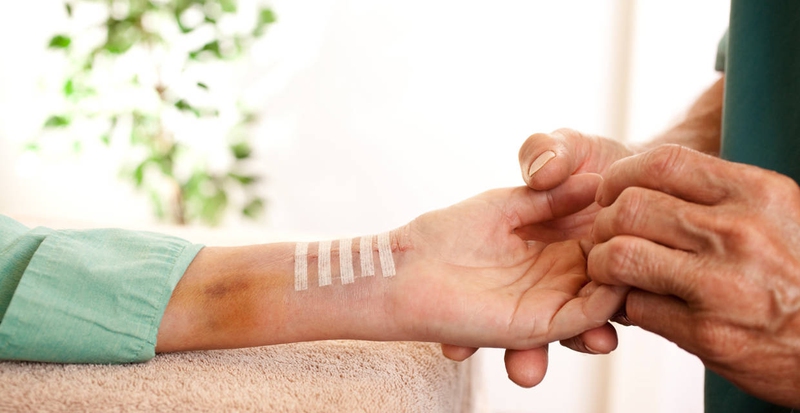Everyone gets cuts and scrapes once in a while. The severity and cause varies widely. There are 5 types of open wounds including incisions, lacerations, avulsions, punctures and abrasions. It is usually hard to tell whether a cut or wound will require stitches since most cuts usually heal without the need for medical intervention. No matter the type of cut you have, it is important to start treatment as soon as possible to stave off infections. Most cuts that require closure can be stapled, stitched or simply closed with skin adhesives within 8 hours of the injury. Minor cuts should be treated within 24 hours.

When Does a Cut Need Stitches?
Location
If the cut is on a part of the body where there’s a lot of movement such as the knee area, it might require stitching to avoid reopening whenever the skin is stretched. Any cuts on areas of the body where there are joints might be eligible for stitching. Areas with a lot of blood vessels like the scalp often require stitches to help stop bleeding. Facial cuts often require stitches to help keep the scar as small as possible and in a straight line.
Depth
When does a cut need stitches? When the cut is more than a ¼ inch deep, it might need some stitching. If the cut is so deep that you can see bone or yellow fatty tissue, you should consult your doctor about getting stitched up.
Width
How wide is the wound? Do the edges need to be pulled together to cover the exposed tissue? If this is the case, then stitches might be required. Stitches will help prevent infection and speed up recovery for this kind of cut.
Animal Bites
Most animal bites might need stitches and oral antibiotics.
Healing and Aftercare for Stitches
If you have a cut that’s been stitched up you need to keep the area around it clean and dry, and closely monitor the wound for swelling, pain or redness. This greatly reduces your chances of developing an infection. If you’re not sure how you should take care of the stitched up cut, consult with your doctor. Alternatively you can follow the general advice given below:
Make sure to protect your stitches. Keep the area bandaged and dry for the first day. Even though the stitches are strong, scratching or impact can cause damage.
After the bandage is off, keep the area around the cut clean. Use clean water to wash the area twice a day. Avoid using alcohol or hydrogen peroxide as they slow down the healing process.
Apply antibiotic ointments to the stitched cut during the first week to prevent bacterial infections that can impede healing. After the first week, cover the stitched area with a layer of petroleum jelly and nonstick bandage whenever you’re going out.
Avoid all sorts of contact sports to give your wound time to heal. You should also avoid swimming.
You can wash the stitched area after 1 to 3 days. Wash off any dirt that forms around the stitches to avoid infection. Make sure to dry it well after washing.
Stitch Removal
Now that you have the answer to “when does a cut need stitches?”, how do you remove the stitches after you’ve healed? Stitches made of dissolvable material do not require removal. Your doctor should tell you if you’re required to remove the stiches and when you are due. You should never try to remove the stitches by yourself. Stitches on the head should be removed from between 3 to 5 days after the procedure. Stitches over joints such as the elbows and knees usually take a bit longer – about 10 – 14 days. For stitches on other parts of the body, you will need to go back to your doctor for removal after 7 to 10 days.
Signs of Infection
There are times when the cut can get infected even after stitching. You should watch out for the signs below:
Swelling
Redness in the area around the cut
Bleeding and pus after you’ve been stitched
Unpleasant smell emanating from the cut
Feeling warm around the area
Increased pain
Swollen glands
Should you experience any of the above symptoms, call or visit your doctor for advice.
Tips and Precautions
1. Other than asking your doctor “when does a cut need stitches?”, make sure to ask them about getting a tetanus shot. If it has been longer than ten years since you got your last one you will need to get re-vaccinated. You risk getting an infection called lockjaw that is characterized by stiffness of the jaw if you do not get the jab.
2. You should consult your doctor if your stitches come apart, you notice blood soaking through the bandages after you’ve been stitched up, you are unable to move the joint in the area around the cut, you feel sudden numbness around the cut, or notice red streaks coming from the cut.
3. After you get a cut, the first thing you should do is to try and stop the bleeding. You can do this by applying pressure using a bandage, paper towel or clean cloth. Try to raise the injured area above the level of the heart and clean the wound with soap and water. If you’ve been impaled by a foreign object, do not try to remove it yourself. See a doctor immediately.
View All Comments /Add Comment